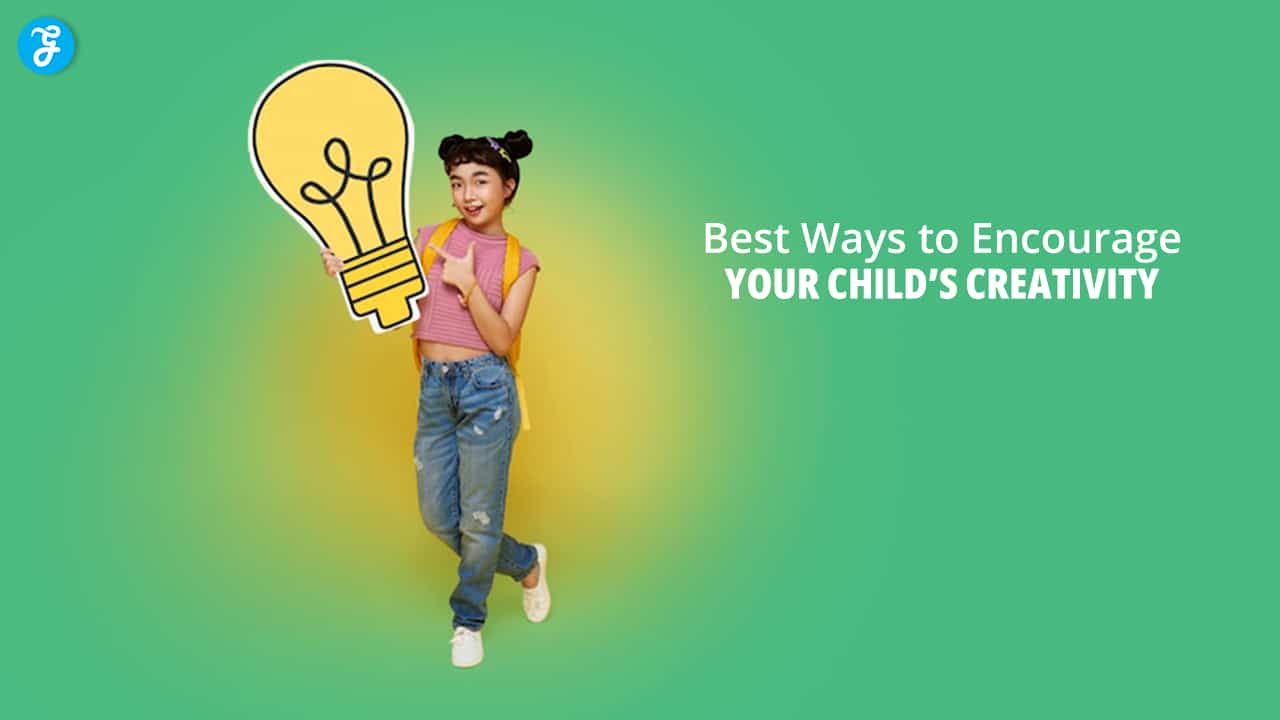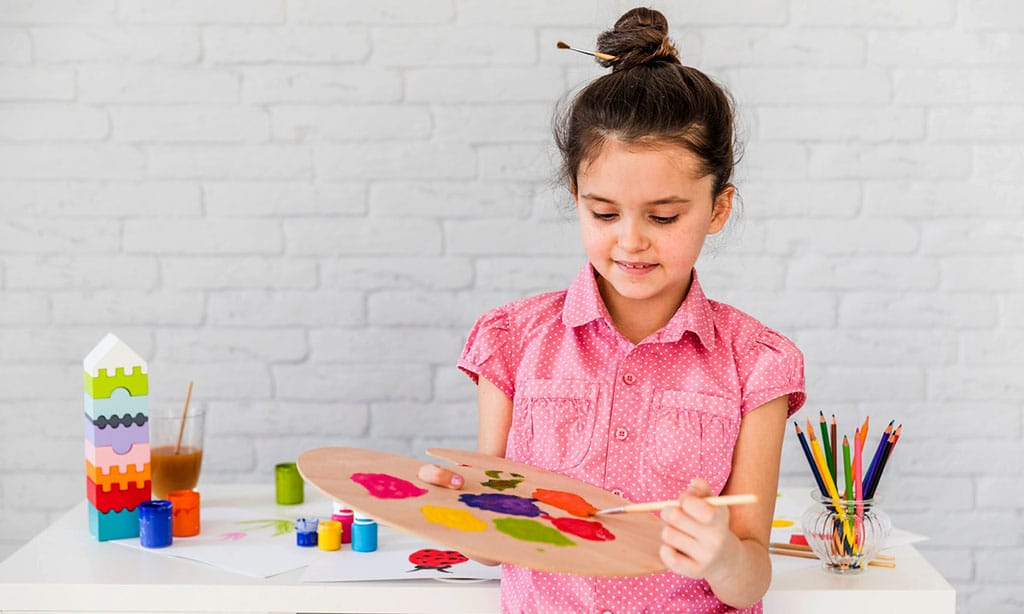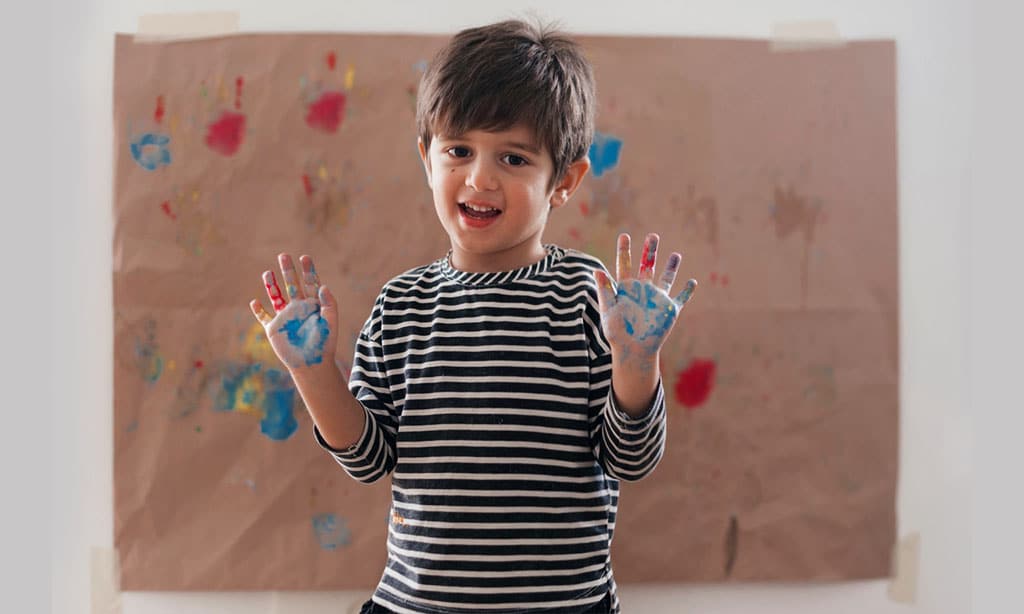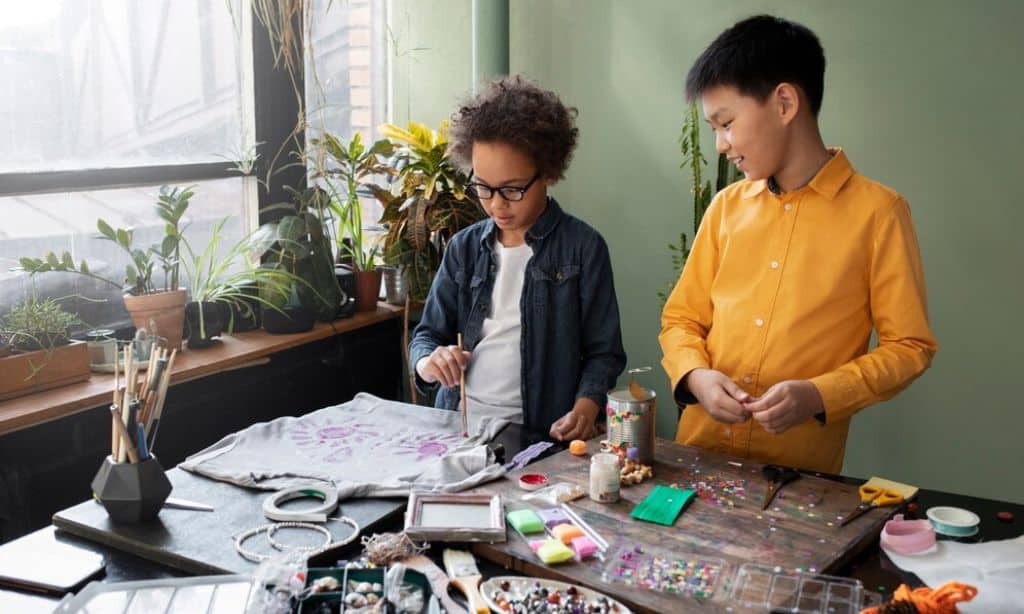Creativity is a valuable skill for children to develop. It helps them think outside the box and solve problems in new ways. As a parent, you play a crucial role in nurturing your child’s creative side.
There are many simple ways to encourage creativity in your kids at home. You can set up art stations, read books together, or play imaginative games. By giving your child the space and tools to be creative, you help them grow into innovative thinkers.
This article will explore 20 fun and easy ideas to spark your child’s imagination and creative potential.
1. Explore Nature Together
Nature is a great place to spark your child’s creativity. Take walks in parks or forests with your kids. Look closely at plants, rocks, and insects together.
Let your children collect natural objects like leaves, acorns, or pretty stones. They can use these items to make art projects at home.
Encourage your kids to draw or paint what they see outdoors. This helps them observe details and express their ideas.
Try making nature scavenger hunts. Give your children a list of things to find, like a red leaf or a smooth rock. This makes exploring fun and engaging.
2. Provide Art Supplies
Give your child easy access to art materials. Stock up on crayons, markers, colored pencils, and paper. Add paint, brushes, clay, and craft supplies too.
Keep everything organized in bins or drawers. Put supplies where your child can reach them safely. This lets them create whenever inspiration strikes.
Rotate materials to keep things fresh. Introduce new items like glitter, stickers, or fabric scraps. This sparks curiosity and new ideas.
Don’t forget about digital tools. Art apps and programs can be great for older kids. They open up new creative possibilities.
3. Read Together
Reading with your child sparks their imagination. Pick books with vivid stories and colorful pictures. Let your child choose what to read. This gives them control and makes reading fun.
Act out the characters’ voices as you read. Ask your child what they think will happen next. This gets them thinking creatively about the story.
After reading, talk about the book. Ask what they liked best or how they would change the ending. This helps them see stories in new ways.
Try making up your own stories together, too. Take turns adding to the tale. This boosts your child’s storytelling skills and creativity.
4. Build a Storytelling Habit
Storytelling can spark your child’s imagination. Make it a daily routine. Set aside time each day for stories.
You can read books together or make up tales. Ask your child to join in. Let them add characters or plot twists.
Try different story starters. “What if…” questions work well. They push kids to think creatively.
Encourage your child to tell their own stories, too. Listen closely and ask questions. This shows you value their ideas.
Use everyday objects as prompts. A spoon could become a magic wand in a story. This teaches kids to see things in new ways.
5. Encourage Questioning
Kids are naturally curious. They want to know how things work and why things happen. You can help them grow this curiosity by encouraging them to ask questions.
When your child asks something, don’t just give a quick answer. Instead, ask what they think. This makes them use their imagination and come up with ideas.
Try asking open-ended questions, too. These are questions that don’t have just one correct answer. For example, “What would happen if cars could fly?” This type of question gets kids thinking creatively.
Remember, there are no silly questions. Every question is a chance for your child to learn and grow. So keep listening and keep asking!
6. Visit Museums
Museums are great places to spark your child’s creativity. They offer kids a world of art, culture, and ideas to explore. Take your child to art, science, history, and more museums.
Let your child lead the way. Ask what catches their eye. Talk about the exhibits together. Many museums have hands-on areas for kids to touch and create.
Look for unique kids’ programs or workshops. These can give your child a chance to make art or try experiments. Some museums even let kids be “junior curators” for a day.
Don’t rush. Give your child time to look, think, and ask questions. Their curious minds will soak up new ideas and inspiration.
7. Create a Craft Corner
Making a craft corner in your home can spark your child’s creativity. Pick a spot that’s easy to clean and has good lighting. Set up a small table and comfortable chairs.
Stock the area with art supplies. Include crayons, markers, paper, glue, and scissors. Add fun items like stickers, pipe cleaners, and pom-poms. Keep everything organized in clear containers.
Display your child’s artwork on the walls. This will make them proud and inspire new ideas. Rotate the art to keep the space fresh and exciting.
Let your child help design the craft corner. They can choose colors or decorations. This will make them feel ownership of the space and want to use it more.
8. Introduce Musical Instruments
Musical instruments can spark your child’s creativity. Try giving them simple instruments like drums, xylophones, or shakers. Let them explore different sounds and rhythms freely.
You can also make DIY instruments at home. Use empty containers for drums or fill bottles with rice for shakers. This lets your child get hands-on with music-making.
Encourage your child to create their songs using the instruments. Don’t worry about perfect pitch or rhythm. The goal is to have fun and express themselves through sound.
9. Engage in Role-Playing
Role-playing helps kids explore their imagination. You can set up fun scenarios at home for your child to act out. Try playing in a restaurant where your kid is the chef or waiter. Or create a pretend store where they can be the shopkeeper.
Dress-up clothes and simple props make role-play more exciting. Old garments, hats, and toy accessories work great. Let your child lead the play and come up with their characters and stories.
Role-playing builds social skills and problem-solving abilities. It lets kids practice different ways of talking and acting. They can try out being a doctor, teacher, or even superhero. This helps them see things from new points of view.
10. Practice Photography
Photography helps kids see the world in new ways. Give your child a camera and let them explore. They can take pictures of nature, family, or anything that interests them.
Encourage your child to try different types of photos. They can do portraits, landscapes, or close-ups. Let them experiment with angles and lighting.
Go on photo walks together. Visit parks, neighborhoods, or events. This gives your child chances to capture various subjects.
Teach basic photography skills. Show them how to frame shots and use the camera settings. Let them practice and learn from their mistakes.
Display your child’s photos at home. This boosts their confidence and inspires more creativity.
11. Cook Together
Cooking with your child is a fun way to spark creativity. Let them help plan meals and choose ingredients at the store. In the kitchen, give them age-appropriate tasks like mixing, measuring, or decorating.
Try making up new recipes together. What happens if you add cinnamon to scrambled eggs? Let your child experiment with flavors and textures.
Cooking teaches essential skills like following directions and problem-solving. It also boosts confidence as kids see the results of their work. Plus, you get to enjoy a tasty meal together at the end!
12. Experiment with Science Kits
Science kits can spark your child’s creativity and curiosity. These kits cover topics like chemistry, robotics, and engineering. They come with materials for hands-on projects suited to different ages.
Using science kits, kids can learn problem-solving and critical thinking. They explore physics, geology, and biology concepts through fun experiments. This hands-on approach makes science exciting and accessible.
You can find kits that match your child’s interests. Some focus on electricity, while others explore nature. By doing experiments, kids develop a positive attitude towards science. They also improve their reasoning skills.
Science kits bring learning to life in a fun way. They encourage kids to ask questions and seek answers. This process of discovery helps foster creativity and innovation.
13. Introduce Journaling
Journaling can spark your child’s creativity in fun ways. Get them a special notebook and some colorful pens. Encourage them to write or draw about their day, feelings, or made-up stories.
You can start with simple prompts like “My favorite part of today was…” or “If I could go anywhere, I’d visit…”. This helps kids express themselves freely.
Journaling builds writing skills and boosts imagination. It’s also an excellent way for kids to reflect on their experiences. Try setting aside a few minutes each day for journal time.
Let your child decorate their journal cover. This makes it more personal and exciting to use. Remember, there are no rules – journaling should be enjoyable, not a chore.
14. Play with Building Blocks
Building blocks are great tools for sparking creativity in kids. They let your child’s imagination run wild. Give your kid a set of blocks and watch them build unique structures.
Try different types of blocks. Wooden blocks, plastic bricks, and foam shapes offer unique building experiences. Mix them up to keep things fresh and exciting.
Challenge your child with fun tasks. Ask them to build a bridge between two chairs or create a tower as tall as they are. These games help develop problem-solving skills.
Encourage your kid to make stories with their block creations. A simple tower can become a castle with a brave knight defending it. This helps boost language skills and creativity.
15. Encourage DIY Projects
DIY projects are great for boosting your child’s creativity. Let them make their toys, decorations, or valuable items. Give them materials like cardboard, glue, and paint.
Start with simple projects like paper plate crafts or sock puppets. As they get better, try more complex ideas. Building a birdhouse or designing a board game can be fun challenges.
Let your child lead the project. Help when needed, but don’t take over. This builds their problem-solving skills and confidence. Praise their efforts and display their finished work.
DIY projects teach kids to see everyday objects in new ways. They learn to create something from nothing. This skill will help them think outside the box in other areas of life.
16. Organize Dress-Up Days
Dress-up days can spark your child’s imagination. Set aside time for pretend play with costumes and props.
Let your kid pick a theme, like superheroes or fairy tales. Gather old clothes, hats, and accessories to create outfits.
Encourage your child to invent characters and stories. Ask questions about their made-up world to fuel creativity.
Make it a family activity. Join in and play along with your child’s imaginative scenarios. This shows you value their ideas.
Rotate dress-up items regularly to keep things fresh. Visit thrift stores together to find new costume pieces on a budget.
17. Join a Theatre Group
Theatre groups can spark your child’s creativity. These groups offer a fun way to learn acting, singing, and dancing. Your kid can try new roles and express themselves.
Theatre helps children build confidence. They learn to speak in front of others and work as a team. It also improves memory as they learn lines and movements.
Joining a theatre group lets your child meet new friends. They can work together on shows and learn from each other. This social aspect is significant for their growth.
Look for local theatre groups or drama clubs in your area. Many schools and community centers offer these programs. Sign your child up and watch their creativity bloom on stage.
18. Take Up a New Sport
Starting a new sport can spark your child’s creativity. Sports teach teamwork and problem-solving skills.
Try different activities like soccer, basketball, or swimming. Each sport offers unique ways to think and move.
Encourage your child to come up with game plans or strategies. This helps them use their imagination in new ways.
Sports also build confidence. As your child improves, they may feel more willing to try creative ideas in other areas.
Remember to keep it fun. Let your child choose a sport they enjoy. This will help them stay motivated and creative.
19. Design Digital Art
Digital art opens up new creative possibilities for kids. You can introduce your child to easy-to-use drawing apps and software for young artists. These tools let them experiment with colors, shapes, and effects at the touch of a screen.
Many free online platforms offer simple interfaces for beginners. Your child can create artwork using virtual brushes, stickers, and stamps. They can try more advanced features like layers and filters as they grow more confident.
Encourage your child to mix digital art with traditional methods. They might scan hand-drawn pictures and add digital elements or print digital designs to color by hand. This blending of techniques can spark fresh ideas and keep creativity flowing.
20. Grow a Garden
Gardening is a fun way to spark your child’s creativity. Let them pick out seeds and choose where to plant them. They’ll get excited watching their plants grow day by day.
Give your child a small plot or container to tend to. They can decorate it with painted rocks or little signs. This lets them express themselves while learning about nature.
Encourage your child to try growing unusual plants like rainbow carrots or star-shaped cucumbers. These unique veggies will capture their imagination and make gardening more exciting.
Gardening teaches patience and care. Your child will feel proud when they harvest vegetables they grew themselves. It could inspire them to help cook family meals using their homegrown produce.
Understanding Child Creativity
Creativity in children is a vital aspect of their growth and learning. It shapes how they view the world and solve problems. Let’s explore why it matters and how it shows up differently.
The Importance of Creativity in Childhood Development
Creativity helps kids grow in many ways. It boosts their confidence and self-expression. Children learn to share their ideas and feelings when making art or playing pretend. This builds their social skills, too.
Creative activities also help with problem-solving. Kids who think creatively can come up with new solutions to challenges. This skill is helpful in all parts of life, from school to friendships.
Lastly, creativity makes learning fun. When kids enjoy what they’re doing, they’re more likely to keep trying and improving. This positive attitude can carry over to other areas of their lives.
How Creativity Impacts Learning
Creative thinking helps kids learn better. It allows them to see things from different angles. This can make subjects like math and science more exciting and easier to understand.
When you encourage creativity, you’re also teaching kids to ask questions. Curious children are more engaged in their learning. They want to find out how things work and why things happen.
Creative activities can also improve memory. When kids make up stories or songs about their learning, it helps them remember the information better. This makes studying more effective and enjoyable.
Different Forms of Creativity
Creativity isn’t just about art. It shows up in many ways:
- Artistic creativity: Drawing, painting, sculpting
- Musical creativity: Singing, playing instruments, making up tunes
- Verbal creativity: Storytelling, word games, writing poems
- Physical creativity: Dance, sports, inventing new games
Each form of creativity uses different skills. Some kids excel in one area while others shine in another. It’s important to offer various creative outlets so every child can find their strength.
Problem-solving is another form of creativity. When kids figure out how to build a fort or create a new recipe, they’re being creative. These everyday activities are just as valuable as traditional art forms.
Creating a Nurturing Environment
A supportive space helps kids unleash their creative potential. Setting up the right environment allows children to explore and express themselves.
Encouraging Imagination Through Play
Let kids play freely. Give them open-ended toys like blocks, dress-up clothes, and art supplies. These spark imagination better than toys with set rules.
Ask “What if?” questions to spark new ideas. “What if cars could fly?” or “What if dogs could talk?”
Join in pretend play. Be a customer at their pretend store or a patient at their doctor’s office. Follow their lead and add to the story.
Set up spaces for different types of play. A cozy reading nook, an art corner, or a fort-building area lets kids dive into different creative worlds.
Providing Access to Creative Materials
Keep art supplies within reach. Stock up on paper, crayons, markers, paint, clay, and craft items. Rotate materials to keep things fresh.
Display a “creation station” with random objects. Include things like cardboard tubes, bottle caps, and fabric scraps. Challenge kids to make something new.
Offer musical instruments, even simple ones. Shakers, drums, or xylophones let kids explore sounds and rhythms.
Set up a dress-up box with old clothes and accessories. Add fun items like hats, scarves, and costume jewelry.
Balancing Structure and Freedom
Give kids time for unstructured play. Allow at least an hour each day for free exploration and creativity.
Set some basic rules for creative time. “Clean up when you’re done” and “Ask before using messy materials” create a safe space for creativity.
Offer gentle guidance when needed. If a child feels stuck, suggest, “What if you tried a different color?” or “How could you make it bigger?”
Create a mix of planned and free activities. Balance craft projects or guided art lessons with open-ended creative time.
Supporting Creative Expression
Nurturing your child’s creativity involves actively supporting their ideas and fostering critical thinking skills. Here are practical ways to encourage creative expression in your young ones.
Listening to and Valuing Children’s Ideas
Give your child your full attention when they share their thoughts. Show genuine interest by asking questions about their ideas. Avoid judging or dismissing their concepts, even if they seem unrealistic.
Praise their unique perspectives and encourage them to expand on their thoughts. Create a safe space where they feel comfortable expressing themselves freely.
Set aside time for brainstorming sessions together. Write down all ideas without critique. This teaches your child that every idea has value.
Display their artwork proudly in your home. This shows you value their creative efforts and boosts their confidence to keep creating.
Encouraging Problem Solving and Critical Thinking
Present your child with open-ended challenges. Ask “How could we…” questions to spark their problem-solving skills. For example, “How could we build a fort using only items in this room?”
Break big problems into smaller steps. Guide them through the process of tackling each part separately. This makes complex issues feel more manageable.
Teach basic research skills. Show them how to find answers to their questions using books or safe online resources. This empowers them to seek knowledge independently.
Play strategy games together. Chess, puzzles, and logic games help develop critical thinking in a fun way. Discuss the thinking behind each move to deepen their understanding.
Encourage your child to look at issues from different angles. Ask “What if…” questions to help them consider alternative viewpoints and solutions.
Takeaway
Nurturing your child’s creativity is one of the most rewarding things you can do as a parent.
By encouraging imaginative play, providing access to creative materials, and supporting their unique ideas, you’re helping them develop critical thinking skills that will serve them throughout their lives.
Creativity isn’t just about artistic expression—it’s about problem-solving, innovation, and seeing the world in new ways. By fostering an environment where creativity can flourish, you’re setting your child up for success in all areas of life.
Start incorporating these 20 simple yet effective strategies into your daily routine, and watch as your child’s imagination and creativity blossom.
What are your favorite ways to encourage creativity in your child? Share your tips in the comments below!






































